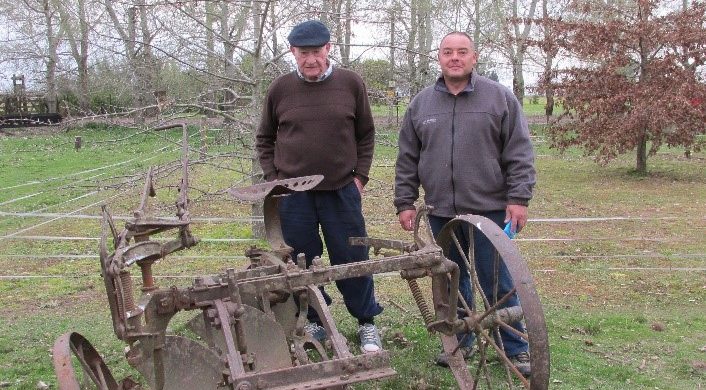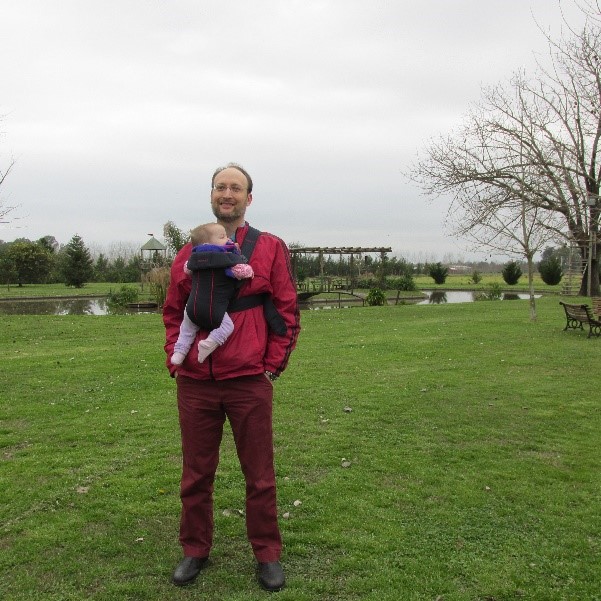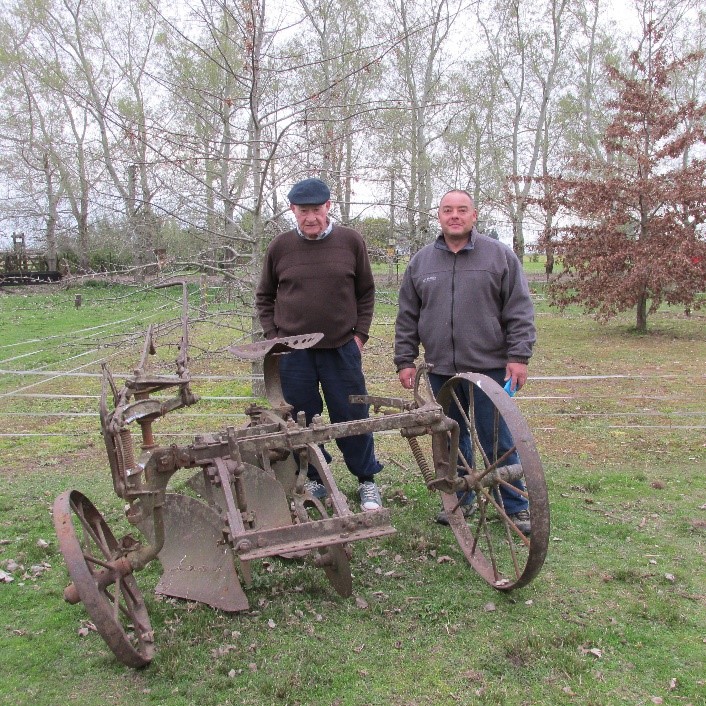
Ways of Seeing Maintenance and Repair, Argentina
Technology’s Stories v. 8, no. 2 – DOI: 10.15763/jou.ts.2020.09.28.01
Pineda_Ways of Seeing Maintenance
Introduction: Representation of Machinery Use in Argentine Culture and Film
In this technology story, I use ethnographic material from my original documentary film, Stories of the Harvester (https://vimeo.com/395115057), to discuss how the camera evokes spectators’ feelings about the subculture of farm machinery. I was influenced by Fernando Birri’s Tire Di’e spectacular film of children in Rosario, Santa Fe dangerously running alongside moving trains in hopes of getting a “dime” from train passengers. (https://www.youtube.com/watch?v=azA-xchfbII). Spectators could feel the children’s desperation, while others felt the passengers’ frustration—should they or should they not throw money out the window? My aim was similar: as I traveled through the productive rural and urban areas of Santa Fe province in Argentina I collected the narratives of townspeople as maintainers of old machinery, local culture, and history. I visited towns, factories, machine warehouses, fields, train stations, and other sites to capture the “aesthetic of labor” through film.[1] In the process, I unwittingly became a character in the film when interviewees requested my presence in front of the camera or when I acquiesced (subconsciously or consciously) to become the “North American woman” that they imagined.
In “Can the subaltern speak?” Gayatri Spivak argues that the subaltern cannot speak, for how can they speak if they’re not physically free or are not allowed to voice an opinion without retaliation?[2] As Amartya Sen may say, do they have entitlements and capabilities?[3] Spivak is one of the founders of subaltern studies. These pioneers revealed the universalism/eurocentrism/Western ideology that limits scholarly understanding of the subaltern and subcultures, especially those of the Global South.[4] We could deduce from subaltern studies that only intimate ethnographic studies can uncover every day physical and mental rituals of the subaltern, such as ones that preserve household and collective memory in rural regions.[5] Even without such studies, however, there are ways of understanding how the subaltern or subcultures “can speak.” Nicholas Mirzoeff and Bruno Munari, for instance, argue that to understand the everyday practices and rituals of people unknown to us, we can see it through their art, film, literature, material and cultural artifacts.[6] From Brazil and South Africa, Augusto Boal and William Kentridge use performance and everyday acts of emancipation (resistance) from the oppressed to understand their viewpoint.[7]
In the short film, the interviewees are representing themselves of their own volition, but they are cognizant that they’re talking to the director/interviewer as a representative of the Global North. So, in Stories, whose representation is it anyway? Selecting only 24 minutes out of nearly 100 hours of raw film and audio footage and nearly 1000 photographs of machines, I could only allow a spectator see what they want to see, but the spectator can also take time to reflect on why they see what they see. My film is only a small sample among thousands that illustrate the importance of farm machinery technology to Argentine rural society, and I use it here as a primary source to show how the descendants of European and internal migrants created an independent identity revolving around machinery in Santa Fe province, Argentina. They forged this identity through decades of repairing and maintaining farm machinery for both practical and cultural reasons, despite climate disruptions, political persecution, and economic instability.
Representation from the User’s Perspective
During the twentieth century, Argentine forgers and blacksmiths were largely on their own weathering the turbulent environmental and economic conditions of the country. Using their practical experience repairing hundreds of foreign machines and implements, they developed their own original machinery. The pampas contained a diverse world of tenant farmers (arrendatarios), small-scale farmers (chacareros), blacksmiths (herreros), and unskilled workers (changarines) who designed machinery or labored in shops that built these machines. At times, they patented or copyrighted their inventions or designs of plows, harvesters and threshers, selling them to local markets. Among themselves, they exchanged know-how and heuristic techniques as they shaped machinery based on local-level farming needs and practices.[8]
Who does Stories represent? It represents a subculture of persons in San Vicente and Humboldt, Santa Fe interviewed by a North American woman who drove across the pampas with her family to record their stories (See Figure 1) Though I was a perfect stranger to the interviewees, they felt comfortable speaking about machinery to me as part of a shared global history of farm machinery. The interviewees were industrial designers, mechanics, aficionados, preservationists, and maintainers. Above all, they are maintainers, and not merely recipients of transferred technology from the North Atlantic. They were self-trained inventors who made productive machinery as well as learned how to repair foreign farm machinery by studying Spanish-language machine manuals, passing down knowledge to succeeding generations, or collaborating with foreign or state-trained engineers to create new machine designs. Together, they took into account local environmental conditions and solved the challenge of securing raw materials, such as fuel and metals.

Figure 1. Director’s Family in the Pampas, Salvatorre Ranch. (Buenos Aires province, Photo by Author, 2014)
Beyond its mere practical value, farm machinery had cultural significance for the people of Santa Fe. Individuals remember their old machinery as a provider, helper, and significant metal other, and oftentimes if they had the space, they would create family museums on their land. The Salvatorre family in Buenos Aires province near Carmen del Areco generously gave a walking tour of the antique farm machinery they displayed on their land. The machine represented the virtues of autonomy and independent learning that was associated with pride in hard work. Laboring with farm machinery was not an easy task, and the knowledge of how to work was often passed down from old to young males, such as the father and son pictured in Figure 2. For instance, the patriarch of the family, Roberto, maintained a series of machines that had been used in his family since the nineteenth century. In this serendipitous moment, the father looked away from the camera, focusing instead on the machine. His son standing next to him had made a hobby of restoring old machinery, and shared videos of his work in tractor restoration. This video stored on his smartphone introduced outsiders through videos to what users and maintainers see.

Figure 2. Father and Son of the Salvatorre Family Ranch (Buenos Aires province, Photo by Author, 2014)
From a user’s perspective, the movement, the light, the sound, and even physiological changes are clear. For instance, another interviewee Gabriel Ardusso who is a mechanic, restorer, and contractor of old farm machinery shared his photos of restored machinery. The more insightful videos, however, are the clips he made himself first as spectator and second as driver/user of a combine harvester. Video 1 “Gabriel Ardusso as Spectator” shows the machine working. Ardusso is outside the machine, filming as spectator. The handheld image is relatively stable, the sounds are both mechanical and natural, such as the crushing of the grass as he walks, and the wind blowing. Underneath it, we hear Ardusso’s breathing. The presumably annoyed driver honks as he passes by Ardusso who is dangerously close to the harvesting machine. He risks his life to bring us this footage of 1 minute and 42 seconds to show as many angles as he can of how the machine works.
By contrast, in video 2 “Gabriel Ardusso as User (co-driver) again risks his life by filming while driving a harvester combine. The viewer sees the machine from inside the harvester cabin. The image is unstable; the machine sounds are deeper and unpleasant, with moments of loud grinding sounds as the machine tears up the earth. Through this perspective, viewers feel the sensation of the machine’s movement, especially the bumpy, dusty ride on a presumably hot day. The most significant part of the film is its short length, 22 seconds, because Ardusso has no time to film—he must drive. But those 22 seconds are sufficient for the human body to feel the jarring physiological sensations of heat, dust, and loud noise—such is life working as a contractor!
Beyond the practical value of designing a combine harvester to do difficult farm work, farm machinery had cultural significance for people in Santa Fe. In the rural pampas, designs of harvesters and tractors were conceptually synonymous with community development through the creation and application of new ways of doing things. Tangible design or intangible creativity relied on practical intelligence, crafting traditions, and the perception that the machine user was building the nearly perfect machine for the community.
During the late 1920s, Ezra Pound wrote the essay, “Machine Art” on the aesthetics and acoustics of machinery.[9] He is frank: “farm machinery has been…ugly; this ugliness is common to most assemblages of machinery; or to put it another way, farm machinery is usually not a machine, in the scientist’s sense, it is a lot of little machines hitched together.”[10] Regarding the sound, “obviously a boiler factory will never sound like a nocturne of Chopin.”[11] Clearly, machinery is big, cumbersome, ugly, and emits unpleasant sound. Yet the prized metal parts put together have significant meaning to the persons who design or use these machines. Since the nineteenth century, humans have been intrigued by farm machinery—the millions of photos, videos, and machines scattered around the world, a nano sample of which this film represents, attest to its emotional importance despite being ugly or releasing unpleasant sounds.
Yovanna Pineda, Ph.D. is associate professor of history at the University of Central Florida, and director of Stories of the Harvester.
Suggested Readings
Aguilera Skvirsky, S. The Process Genre: Cinema and the Aesthetic of Labor. Durham: Duke University Press, 2020.
Bil, D. Acumulación y proceso productivo en la fabricación de maquinaria agrícola en la Argentina (1870-1975). Elementos de su competitividad en el marco del mercado internacional. (Tesis doctoral inédita). Universidad de Buenos Aires, 2009.
Birri, F. Tire Di’e. Documentary film with English subtitles: https://www.youtube.com/watch?v=azA-xchfbII
Boal, A. Theatre of the Oppressed. New York: Theatre Communications Group, 1985
Castelo di Rivoli Museo d’Arte. William Kentridge. Milan: Skira Editore S.p.A., 2004.
Gudeman, S. et al. Economy and Ritual: Studies of Postsocialist Transformations. New York: Berhahn Books, 2017.
Guha, R. A Subaltern Studies Reader, 1986-1995. Minneapolis: University of Minnesota Press, 1997.
Mirzoeff, N. How to See the World. Penguin Random House UK, 2015.
Mignolo, Walter D. Local Histories/Global Designs: Coloniality, Subaltern Knowledges, and Border Thinking. Princeton: Princeton University Press, 2000.
Munari, B. Design as Art. Reprint. Penguin Random House UK, 2008.
Pineda, Y. “International and Local Collaboration in the Social Design of the Harvester in Argentina during the Long Twentieth Century (1900-2010),” Historia agraria de américa Latina, 1:1(2020): 70-93.
Pound, E. “Machine Art (1927-1930),” pp. 57-83. In Ardizzone, M.L. Machine Art & Other Writings: The Lost Thought of the Italian Years. Durham: Duke University Press, 1996
Said, E. Orientalism. 25th Anniversiary Edition. New York: Vintage, 1994
Sarkar, S. Writing Social History. Delhi & New York: Oxford University Press, 1997
Sen, A. Development as Freedom. Reprint. New York: Anchor, 2000.
Spivak, G. “Can the Subaltern Speak,” pp. 271-314. In Cary Nelson et al., Marxism and the Interpretation of Culture. Urbana-Champaign: University of Illinois Press, 1988.
Strebel, I. et al., editors. Repair Work Ethnographies: Revisiting Breakdown, Relocating Materiality. Singapore: Palgrave MacMillan.
Copyright 2020 Yovanna Pineda
Notes
[1] Skvirsky Aguilera, The Process Genre: Cinema and the Aesthetic of Labor. Durham: Duke University Press, 2020.
[2] Gyatri Spinvak,“Can the Subaltern Speak?”, in Cary Nelson et al., Marxism and the Interpretation of Culture, (Urbana-Champaign: University of Illinois Press, 1988, 271-314.
[3] Amartya Sen, Development as Freedom, (New York: Anchor Books) 2000.
[4] Spivak, “Can the Subaltern Speak?”; Ramachandra Guha, A Subaltern Studies Reader, 1986-1995, (Minneapolis: University of Minnesota Press, 1997); Edward Said, Orientalism, 25th Anniversary Edition, (New York:Vintage, 1994).
[5]S. Gudeman et al. Economy and Ritual: Studies of Postsocialist Transformations, (New York: Berghahn Books, 2017).
[6] Nicholas Mirzoeff, How to See the World (London: Penguin Random House UK), 2015; Bruno Munari, Design as Art, reprint (London: Penguin Random House UK), 2008. Castelo di Rivoli Museo d’Arte. William Kentridge. Milan: Skira Editore S.p.A. 2004.
[7] Augusto Boal, Theatre of the Oppressed. (New York: Theatre Communications Group, 1985); Castelo di Rivoli Museo d’Arte, William Kentridge, (Milan: Skira Editore S.p.A. 2004).
[8] Ezio Manzini, Design, When Everybody Designs: An Introduction to Design for Social Innovation (Cambridge: MIT Press, 2015).
[9] Ezra Pound, “Machine Art (1927-1930),” In M.L. Ardizzone, Machine Art & Other Writings: The Lost Thought of the Italian Years, (Durham: Duke University Press, 1996), 57-83
[10] Ibid., 58.
[11] Ibid., 73.
